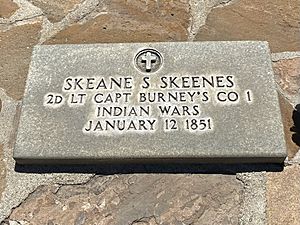Mariposa War facts for kids
The Mariposa War (December 1850 - June 1851) occurred between Native Americans and miners in Mariposa in central California. The conflict arose following the California Gold Rush when thousands of settlers, immigrants and prospectors entered Native American lands through the California Trail. In several campaigns, the specially-raised Mariposa Battalion brutally raided and destroyed the villages of Native Americans throughout the region. The war is part of the California genocide, in which thousands of indigenous peoples of California were killed by agents and forces of the United States government and private citizens in the 19th century.
Background
The cause of the conflict was the California Gold Rush. After the discovery of gold on January 24, 1848, an overland route very quickly developed southward to Sutter's Mill from the Oregon Trail at Fort Hall in Oregon Country (now Idaho). By the end of May 1849, more than 40,000 gold seekers had used the California Trail to enter northern and central California which had been up until then populated by Native Americans and Californios (the descendants of early Spanish settlers). In three years, the non-Native American population rose from 14,000 in 1848 to 200,000 in 1852. Immigrants had come from Mexico, South America, Europe, Australia, and China.
Miners searching for gold forced Native Americans off their historic lands. Many others were pressed into service in the mines; others had their villages raided by the army and volunteer militia. In December 1850, the Ahwahneechees and the Chowchilla in the Sierra Nevada and San Joaquin Valley fought back leading a raid on the Fresno River post of James D. Savage.

With the support of Mariposa County Sheriff James Burney, Savage led a militia of seventy four men in a retaliatory attack against a Chowchilla camp on the Fresno River near present-day Oakhurst, California on January 11, 1851. The militia attacked with rifles at daylight but were surprised when the Chowchilla returned fire with rifles and pistols of their own. Surprised and unprepared, Savage's forces staggered and dispersed, resulting in a victory for the Native Americans in what would become known as the first battle of the Mariposa War.
War
Mobilization
Burney made an appeal to John McDougal, the second Governor of California. This led to the creation of the Mariposa Battalion, a Californian State Militia, under "Major" James D. Savage. Its commands were:
- Company A : 70 men, led by Capt. John J. Kuykendall
- Company B : 72 men led by Capt. John Boling
- Company C : 56 men led by Capt. William Dill
Besides the military, officials from the Federal Indian commission sought a peaceful solution. On March 19, 1851, the Commissioners signed a treaty at Camp Fremont aside Mariposa Creek with six tribes. However, as the Ahwahneechees and Chowchillas were absent from the talks, a military campaign was launched against them the same day.
First campaign
The military action began when Company A — led by Captain Kuykendall — proceeded south to the King's and upper Kaweah Rivers and to the Tulare Valley. After arriving at the King's River, scouts located a large Chowchilla village nearby. Company A charged into the Chowchilla camp, killing Native Americans. Some survivors were pursued, ridden down and taken prisoner. However, as Kuykendall's men had abandoned their horses for the village charge, many of the Chowchilla were able to escape on foot.
After the village attack, Kuykendall ordered his command to move onto the headwaters of the Kahweah River where they were unable to locate any more Chowchilla. A few days later, a group of Chowchilla entered their camp to sue for peace. The offer of peace was accepted and arrangements were made to transport the surviving Chowchilla to the reservation on the San Joaquin River. Following the transport, Kuykendall returned to the battalion's camp and headquarters on Mariposa Creek in early April.
Meanwhile, in their first campaign, the companies B and C of Boling and Dill had pursued Native Americans into the mountains where the units often forced to march through rain, sleet and deep snow drifts. on March 27, the companies discovered an Ahwahneechees Yosemite Valley refuge but few natives.
Second Campaign
On April 13, a new campaign against the Chowchilla was launched. Although units from the Mariposa Battalion destroyed the tribe's food stores, most Native Americans were able to elude the militias. However, with the death of their chief, the remaining Chowchilla surrendered and were transported onto a reservation.
Third Campaign
After the Ahwahneechees refused to come to Camp Barbour, the Californian government launched a third campaign against them. The Mariposa Battalion encircled the Ahwahneechees at Lake Tenaija (named for their chief, Tenaya) on May 22. With little prospect of winning, the tribe acquiesced and surrendered Yosemite valley and the surrounding areas to the Californian government. The Battalion, acting as guards, marched the natives to the Fresno River Farm Reservation. After the Ahwahneechees were on the reservation, the militia returned to the Mariposa Creek post. On July 1, 1852, the Mariposa Battalion was mustered out.
See also
 In Spanish: Guerra Mariposa para niños
In Spanish: Guerra Mariposa para niños

